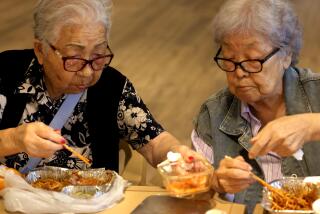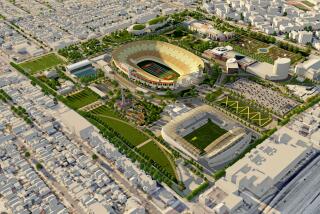Panel Expands to Give Better Voice to Little Tokyo Advocates of Gym
Yielding to pressure from supporters of a proposed community gymnasium in Little Tokyo, the decision-making body for the Central Avenue Art Park project has broadened its membership to better reflect the community, including neighborhood residents.
Under the revised scheme, Little Tokyo residents, businesses, and property owners each get a vote on the executive committee, which has been expanded from nine to 19 members. The Little Tokyo Service Center, a prime mover behind the gym project, now has two votes instead of one.
“I think it’s pretty fair now,” said Brian Kito, a Little Tokyo resident and business owner who has long supported a gym in the historic district.
Kito, whose grandparents settled in Little Tokyo at the turn of the 20th century, represents business owners on the panel.
The executive committee is authorized to recommend to the city how the remaining city-owned land north of historic shops on 1st Street, between Alameda and Judge John Aiso streets, should be used in the proposed Art Park.
Kito predicted that future discussions on the project will be less contentious.
During last month’s heated exchanges at the Japanese American National Museum, critics accused two key players on the executive committee--the Japanese American National Museum and the Museum of Contemporary Art--of ignoring the opinions of Little Tokyo residents. They also claimed that the panel did not represent the community because its membership was two-tiered. The two museums each had two votes, while other groups had only one each.
Now, five other large organizations also have two votes.
A multipurpose gym for Little Tokyo, combining sports and community activities, has been a wish of Japanese Americans in Southern California for decades.
In 1995, a group organized by Bill Watanabe, executive director of the Little Tokyo Service Center, proposed building a gym along Temple near Alameda. But his group was told by Councilwoman Rita Waters, whose district includes Little Tokyo, to look elsewhere because the city planned to use the area for green space.
Gym proponents spent four years looking for other sites, but they say they did not find anything appropriate.
The issue came to a head after the city allowed the Children’s Museum to build its new downtown facility at the location where gym backers had proposed their project.
Backers of the gym want the city to let them build the gym at the Art Park, adjacent to the proposed Children’s Museum on the parcel at the southeast corner of Temple and Judge John Aiso streets.
There is room for both the recreational facility and the museum, gym backers say.
Walters has said that a gym at that location is not compatible with her vision for “an engaging cultural and artistic destination” that would include significant green space. Instead of the gym, she wants the garage at the contested site to be redeveloped as an underground parking structure, leaving room for grass and trees above.
Last weekend, a coalition of groups supporting the gym changed the name of the proposed project to the Little Tokyo Recreational Center.
Watanabe said the new name is more fitting because the facility would be used not only for basketball and other sports but also for many community activities, ranging from cooking and flower arrangement classes to programs for seniors.
A team of high school and college student volunteers is working hard to win additional backing for the project.
“It will bring a lot of people to Little Tokyo,” said Brian Nagami, who will be a senior at UCLA this fall.
“This is the most important thing for Little Tokyo,” said Peter Gee, who will be a senior at Pilgrim School, a private institution in the Mid-Wilshire district. He said Children’s Museum, the Art Park and a recreational center will all help Little Tokyo.
“There is no reason why we can’t all get along,” he said.
More to Read
Sign up for Essential California
The most important California stories and recommendations in your inbox every morning.
You may occasionally receive promotional content from the Los Angeles Times.










